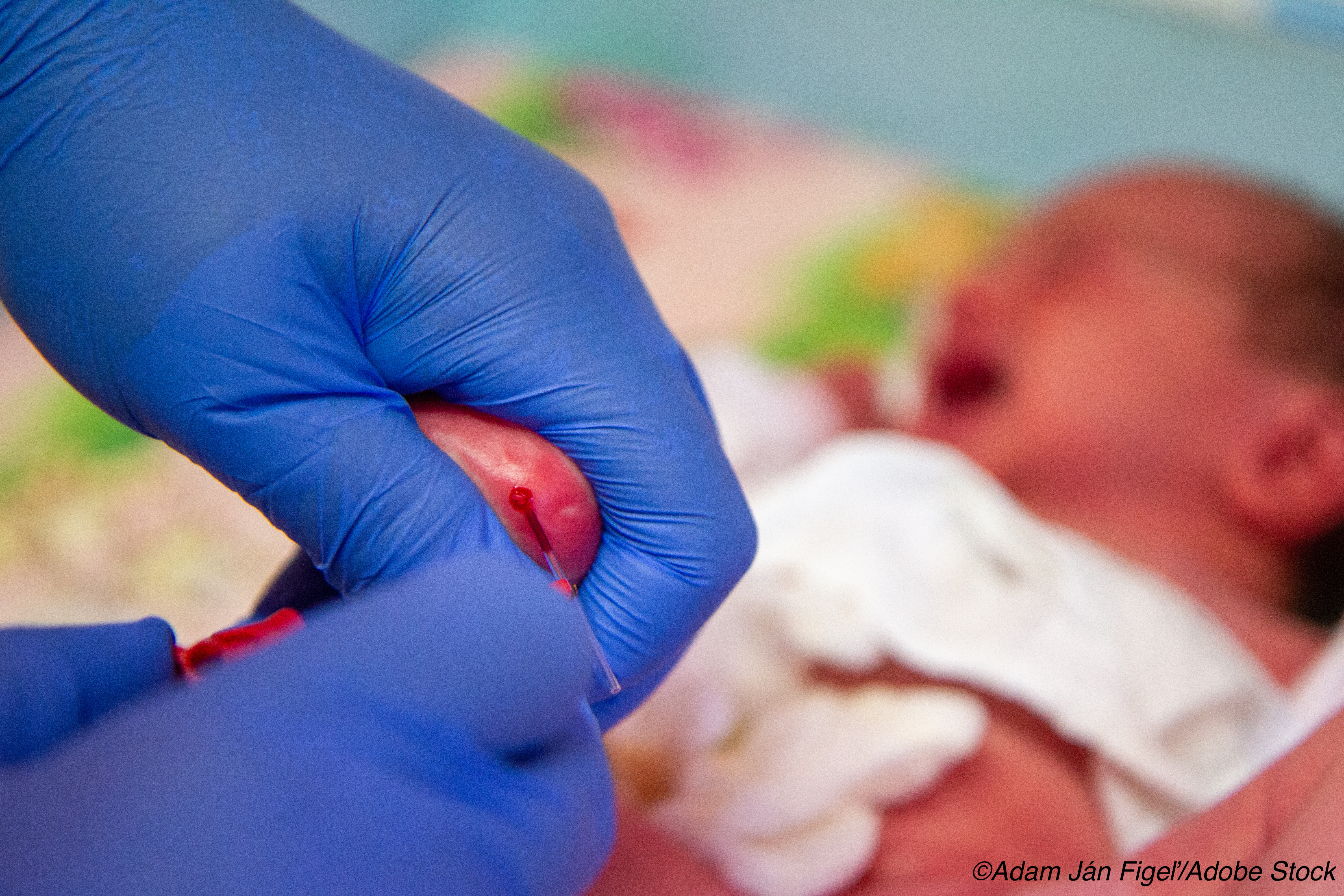 Dried blood spot (DBS) analysis with a widely available assay showed promise for detecting the presence of congenital cytomegalovirus (cCMV) in newborns, researchers reported.
Dried blood spot (DBS) analysis with a widely available assay showed promise for detecting the presence of congenital cytomegalovirus (cCMV) in newborns, researchers reported.
DBS samples were tested for CMV DNA by polymerase chain reaction (PCR) analysis at the University of Minnesota and the CDC, explained Sheila C. Dollard, PhD, of the CDC in Atlanta, and co-authors.
Of the 12,554 study enrollees, 56 newborns were confirmed to have cCMV (4.5 per 1,000, 95% CI 3.3 to 5.7), and the combined DBS results from either UMN or CDC had a sensitivity of 85.7% (95% CI 74.3% to 92.6%), a specificity of 100.0% (95% CI 100.0% to 100.0%), a positive predictive value (PPV) of 98.0% (95% CI 89.3% to 99.6%), and a negative predictive value (NPV) of 99.9% (95% CI 99.9% to 100.0%), they reported in JAMA Pediatrics.
Testing with saliva swabs led to a sensitivity of 92.9% (95% CI 83.0% to 97.2%), specificity of 99.9% (95% CI 99.9% to 100.0%), PPV of 86.7% (95% CI 75.8% to 93.1%), and NPV of 100.0% (95% CI 99.9% to 100.0%), they added.
“The main finding of our study was the enhanced sensitivity of DBS PCR for identification of cCMV… compared with previous studies,” Dollard’s group wrote. “The main reasons for increased sensitivity are most likely because of improved methodologies,” such as the Qiagen DNA extractor and the Quanta DBS elution buffer.
However, they acknowledged that, based on this interim analysis, the “75% average sensitivity of DBS for the two assays in our study remains suboptimal for screening,” but “further improvements in methodologies for DNA extraction and PCR should allow for better sensitivity with the individual tests.”
Also, false-positive (FP) results with saliva screening was a study limitation, which Dollard’s group attributed to the colonization of the neonatal oropharynx with CMV DNA from colostrum. FP results were 13.3% for saliva versus 2% for DBS. The FP results with saliva screening were similar to those reported by other cCMV studies, so urine analysis confirmation of disease is important, the authors stated.
Finally, they explained that the current sample size was too small to provide reliable estimates for demographic subgroups; however, a larger sample size and more data will be available in two years (n=25,000 projected enrollment for the study). Additionally, they will follow-up infants with confirmed cCMV for up to four years of age to assess all clinical outcomes.
In an editorial accompanying the study, Gail J. Demmler-Harrison, MD, of the Baylor College of Medicine and Infectious Disease Service in Houston, noted that DBS analysis to diagnose CMV was first adapted by research scientists in 1994, and efforts to improve methodologies have been ongoing.
“By using enhanced PCR methods, [the authors] have rekindled the hope that NBDBS [newborn DBS] testing may be a viable method for large-scale, universal newborn screening for congenital CMV,” she wrote, adding that the adaptation of collection methods, use of “optimal filter paper to enhance DNA adherence,” improvements in DNA elution procedures, and the development of “novel amplification and detection methods,” should result in “newborn DBS [meeting] the challenge and reach the sensitivity and specificity necessary for universal screening for congenital CMV.”
The population-based cohort study took place at five newborn nurseries and three neonatal ICUs in the Minneapolis/Saint Paul area from April 2016 to June 2019. Newborns in the study (75.5% White, another study limitation) had a saliva specimen collected, as well as DBS.
The saliva swabs were tested for CMV at the UMN lab, and served as the standard reference, while DBS specimens were tested for CMV DNA by PCR at both labs. If a newborn screened positive by either DBS or saliva, a urine sample was collected for confirmation of congenital infection.
The main outcome was the number of children with urine-confirmed cCMV and the proportion of them who were CMV positive through DBS screening.
The authors reported that of 56 newborns with confirmed cCMV, 78.6% tested positive by both saliva and DBS, 14.3% tested positive by saliva only, and 7.1% tested positive by DBS only.
DBS results by lab were as follows:
- UMN: 73.2% sensitivity (95% CI 60.4% to 83.0%), 100.0% specificity (95% CI 100.0% to 100.0%), 100.0% PPV (95% CI 91.4% to 100.0%), 99.9% NPV (95% CI 99.8% to 99.9%).
- CDC: 76.8% (95% CI 64.2% to 85.9%), 100.0% (95% CI 100.0% to 100.0%), 97.7% (95% CI 88.2% to 99.6%), and NPV 99.9% (95% CI 99.8% to 99.9%).
Dollard and co-authors also analyzed mean viral loads of the positive CMV samples and found the median viral load was 1.34×106 IU/mL for the 60 positive saliva samples and 6.6×103 IU/mL for 49 positive DBS samples.
Demmler-Harrison posed several questions for which “Long-term follow-up studies of newborns identified with congenital CMV infection by prospective NBDBS testing may be able to answer,” such as “how sensitive must the NBDBS process be to be acceptable for universal screening. Is the current sensitivity adequate if it detects at-risk newborns and reprieves the ones who are destined to escape sequelae?”
-
High sensitivity of dried blood spots (DBS) demonstrated potential usefulness for pinpointing universal chronic cytomegalovirus with polymerase chain reaction (PCR) testing.
-
Sensitivity of DBS PCR testing was 85.7% when results of two labs were combined.
Shalmali Pal, Contributing Writer, BreakingMED™
The study was funded by the CDC, the National Vaccine Program Office, the Minnesota Department of Health Newborn Screening Program, and the University of South Carolina Disability Research and Dissemination Center (DRDC).
Dollard reported no relationships relevant to the contents of this paper to disclose. Co-authors reported support from, and/or relationships with, the CDC, the University of Minnesota, the NIH, DRDC, Moderna Vaccines, Sanofi Vaccines, GlaxoSmithKline Vaccines, and Merck Vaccines.
Demmler-Harrison reported no relationships relevant to the contents of this paper to disclose.
Cat ID: 41
Topic ID: 83,41,496,730,190,41,138,192,241,925

